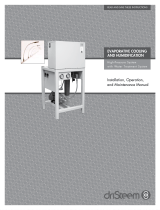
2. All wires that enter the controller should be placed in NEMA-3R, or higher, rated fittings. For UL
purposes, the electrician installing the controller must drill these holes onsite and place the fittings.
3. The first wires connected should run to the solenoid valves and recirculation lines. These wires
connect to the Printed Circuit Board, and are labeled as follows: SOL1, SOL2, SOL3, RECIRC. The
valves are 24V AC, which means that each valve needs two wires to run directly from the board to the
valve. There will not be a common wire used for the valves. If the solenoid valve wires are touching
this will cause continuance in the circuit and will blow the circuit board.
4. The next item connected should be the
pump, and this should be connected to
the contactor in the inputs labeled T1
and T3.
5. The last wires connected should be the
power wires, and these run to the
contactor as well but on the side labeled
L1 and L2. (There are already black
wires running to L1 and L2, but the
power should be wired next to these
wires.) If you use a 240V power source
on the system as manufactured you will
overload the transformer and blow the
circuit board.
6. It is possible to run the system at 240V if
you are using a pump that requires this
much voltage. To do this you must
switch the wire that runs from the
contactor to the terminal block, as
shown in FIGURE 12. This wire needs
to be moved to the terminal that reads
240V on the terminal block. This should
be done before any other wiring is
attached to the controller.
The WetDek AquaDirector can be hooked up to a pool control system, such as the Easy Touch or Aqua
Link. This is accomplished by powering the AquaDirector from one of the free relays on the pool control
system. It is important to follow all of the installation guidelines in this section to avoid damaging the
AquaDirector. If attached to a pool control system, it is possible to run the pump through the pool control
system instead of the AquaDirector, but it is important to insure that the pump cannot be running when
the AquaDirector has stopped running. The AquaDirector is designed to default to an ON position for 30
minutes every time power is returned to the system. It will also remember the last program that was used.
If the pump is setup independently of the AquaDirector, it should be placed on a timer that shuts the
pump off after 30 minutes to prevent damaging a component of the system (i.e. pump, valves, etc…).
WETDEK CONFIGURATION EXAMPLES & GUIDELINES
When building your WetDek configuration, follow these guidelines for best results.
1. All piping from valve to nozzle should be approximately the same length. This will insure that
the water shoots equally from each nozzle.
2. To avoid forming puddles, make sure that the drain is located at the lowest point and that the
surface has a steady slope.
3. Nozzles must be placed so that top surface is level. The surface can slope around the
nozzle, and the ball on the nozzle can be adjusted to aim the water after installation.
4. Surface options are up to the installer; we recommend using stamped or brushed concrete.
ANY SURFACE USED WITH THE WETDEK MUST MEET ANY LOCAL OR NATIONAL
CODES FOR NON-SLIP SURFACES AND HEALTH SAFETY.
The following images show the pipe layouts for the nozzles for various pad configurations. These are
some stock examples, but custom designs are encouraged to give each project a unique feel. Nozzles
should be divided evenly amongst the three zones (Two nozzles per zone for a 6 nozzle kit, three nozzles
per zone for a 9 nozzle kit, and four nozzles per zone for a 12 nozzle kit). Nozzles can be placed
anywhere on the loop to allow for maximum customization.


























